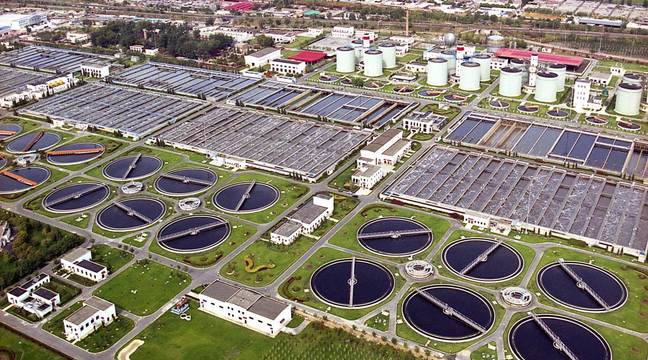
当前课程知识点:Water and Wastewater Treatment Engineering: Biochemical Technology > Chapter 3 Aerobic biofilm process > Section 3.4 Biological contact oxidation process > Section 3.4 Biological contact oxidation process
返回《Water and Wastewater Treatment Engineering: Biochemical Technology》慕课在线视频课程列表
返回《Water and Wastewater Treatment Engineering: Biochemical Technology》慕课在线视频列表
同学们好,下面我们来学习第三章的第四节
生物接触氧化工艺。实际上生物接触氧化工艺
是介于活性污泥法和生物滤池之间的一种生物膜法的处理工艺
有的时候它又称为淹没式的生物滤池
这个图就给出了生物接触氧化工艺的一个基本工艺流程
我们可以看到,进水经过初沉池的预处理之后
就进入生物接触氧化池
随后出水进入二沉池,从这个流程上来看,跟活性污泥的
工艺流程没有本质的差别,但是它在生物接触氧化池中间
跟曝气池相比的话,它有生物填料
所以跟生物滤池相比,它的生物填料是完全淹没
在废水中间的,在里面有曝气
所以我们把它称为是介于活性污泥法和生物滤池之间的一种生物工艺
生物接触氧化工艺的主要的特点是污泥浓度高
因为在生物接触氧化工艺中间,它有两大类的污泥
一类是生长在填料表面的生物膜的污泥的浓度
另一个是悬浮生长在混合液中间的污泥浓度
这两部分加在一起,它的污泥浓度可以到10-20g/L
高于活性污泥法和生物滤池,因此它就能够达到较高的容积负荷
第二是通常情况下不需要污泥回流
也没有污泥膨胀的问题,所以它的运行管理相对简单
由于它的污泥浓度,或者说是它的污泥量相对较高
它对废水的水量和水质的波动有很强的适应能力
因为它又是一种生物膜法
所以它的污泥的产量,要低于活性污泥法
生物接触氧化工艺的组成和主要的构造
我们来看,它由池体、填料、布水系统和曝气系统组成
一般来说,填料的高度是在3.0m左右
填料层上部的水层高度约为0.5m
填料层下部的布水区的高度一般是在0.5-1.5m之间
根据曝气装置跟填料的相对位置,在生物接触氧化工艺中间
可以分成两大类,一大类是曝气装置跟填料分开设置的
生物接触氧化工艺,另外一种是我们常用的曝气装置
直接安装在填料的底部的生物接触氧化工艺
给出的这个结构图,就是曝气装置跟填料分设的
接触氧化工艺,填料区的水流相对稳定
有利于生物膜的生长,但是冲刷力不够
生物膜不容易脱落,或者是在浓度高的情况下
生物膜的厚度,就容易变得比较厚
通常可以采用鼓风曝气或者是表面曝气的装置
这种分置式,它一般是适用于深度处理
我们在通常的情况下,用的更多的
是这种形式,就是曝气装置直接安设在填料的底部
曝气装置多采用鼓风曝气系统
可以充分的利用整个曝气池的容积
填料间有很强的紊流,生物膜的更新非常快
活性也比较高,不会出现堵塞的情况
但是它的困难是由于曝气头安装在填料的底部
所以检修起来比较困难
关于生物接触氧化的填料,我们来看
填料对于生物接触氧化来说非常重要
因为它是微生物生长的载体
它的特性跟生物接触氧化池中间的生物量、氧的利用速率
水流的条件和废水跟生物膜的接触反应的情况
都有直接的影响,一般有多种形式
最早期我们用这种所谓的硬性填料
随后我们用到了软性填料,半软性填料以及球状的悬浮填料
硬性的填料通常是前面的这种块状的
蜂窝状的,或者是波纹状的,这种塑料板或者是塑料块
后期的软性填料是这种纤维状的
这种用绳子串起来的软性填料
后期发展起这种用绳子串起来的半软性的填料
后期也还有这种完全的悬浮在曝气池
混合液中间的球状的悬浮材料
关于生物接触氧化工艺的设计与计算
一般来说我们采用有机容积负荷法来进行计算
至于能够取多高的有机负荷,我们一般
需要通过试验来确定,但是在处理城市废水的时候
一般可以采用1.0-1.8kgBOD5/(m3·d)的容积负荷
要确保废水在曝气池中的水力停留时间
不应该小于1.0h,当然这个里面,是按填料的体积来进行计算
当进水的BOD5的浓度过高的时候
也可以考虑出水回流来稀释进水的BOD5的浓度
相应的提高水力的负荷
设计的计算的方法一般来说,就用这个公式来进行计算
上面是我们每天所需要处理的有机物的量
底部是与BOD5计算的容积负荷
通过这个公式,我们很容易就能算出
生物接触氧化池中间的有效容积,也就是填料的体积
计算完了以后,我们要求出整个池的池深的话
我们就可以用这样的几步来进行计算
总的池深等于填料的高度加上超高,以及填料层上部的水深
和填料池下部到池底之间的高度,这样的话
我们就可以确定整个接触氧化池的总的池深
还有一个是关于水力停留时间
或者说是有效的接触时间
我们用t或者用HRT来表示,也是用V除上Q
V是填料层的有效的容积,Q是处理的水量
关于生物接触氧化工艺的运行与管理来说
它也同样的分为,第一是要实现它的启动和调试
启动和调试的时候需要培养生物膜,它的方法
可以类似于活性污泥的培养,可以间歇运行
或者是连续小流量的进水,在调试过程中间
需要注意废水的营养平衡,其中的碳氮磷的比
以及废水的pH值、以及进水中间含有的一些有毒有害的抑制性的物质
要对生物膜的生长情况进行观察
并且及时的调整运行的条件
在调试运行完成之后,就会进入日常的运行管理
一般我们希望能够控制接触氧化池中间的
溶解氧浓度,在2.5-3.5mg/L,要避免过大的冲击负荷
要防止填料发生堵塞,具体的措施来说
我们可以加强前面的处理,降低进水中的悬浮固体浓度
去掉进水中间的一些悬浮性的物质
第二在一定程度上增大曝气强度
以增强接触氧化池内的紊流程度,对于生物膜进行足够的冲刷
必要的时候还可以采取出水回流
增加水流的上升流速,便于冲刷生物膜
好,这一节的内容我们就到这,谢谢!
-Section 0.1 Development Status of Wastewater Treatment Process
--Section 0.1 Development Status of Wastewater Treatment Process
-Section 0.2 Typical Processes of Wastewater Biological Treatment
--Section 0.2 Typical Processes of Wastewater Biological Treatment
-Section 1.1 Principles of wastewater aerobic biological treatment
--1.1 Principles of wastewater aerobic biological treatment
-Section 1.2 Principles and determination of wastewater biodegradability
--1.2 Principles and determination of wastewater biodegradability
-Section 1.3 Principles of wastewater anaerobic biological treatment
--Section 1.3.1 Principles of wastewater anaerobic biological treatment(1)
--Section 1.3.2 Principles of wastewater anaerobic biological treatment(2)
-Section 1.4 Principles of wastewater biological nitrogen removal
--Section 1.4 Principles of wastewater biological nitrogen removal
-Section 1.5 Principles of wastewater biological phosphorus removal
--Section 1.5 Principles of wastewater biological phosphorus removal
-Chapter 1 Homework
-Section 2.1 Basic concept of activated sludge process
--Section 2.1.1 Basic concept of activated sludge process
--Section 2.1.2 Basic concept of activated sludge process
-Section 2.2 Growth rule of activated sludge and its application
--Section 2.2 Growth rule of activated sludge and its application
-Section 2.3 Running mode of activated sludge process
--Section 2.3.1 Running mode of activated sludge process(1)
--Section 2.3.2 Running mode of activated sludge process(2)
-Section 2.4 Kinetics of active sludge process
--Section 2.4.1 Kinetics of active sludge process(1)
--Section 2.4.2 Kinetics of active sludge process(2)
--Section 2.4.3 Kinetics of active sludge process(3)
--Research and Development of Kinetic Model of Activated Sludge Process
-Section 2.5 Principle, calculation and equipment of aeration
--Section 2.5.1 Principle, calculation and equipment of aeration(1)
--Section 2.5.2 Principle, calculation and equipment of aeration(2)
-Section 2.6 Designing of activated sludge process
--Section 2.6 Designing of activated sludge process
-Section 2.7 Operation and management of active sludge process
--Section 2.7.1 Operation and management of active sludge process (1)
--Section 2.7.2 Operation and management of active sludge process (2)
-Chapter 2 Homework
-Section 3.1 Basic principle of biofilm
--Section 3.1 Basic principle of biofilm
-Section 3.2 Biofilter process
--Section 3.2.1 Biofilter Process (1)
--Section 3.2.2 Biofilter process (2)
--Section 3.2.3 Biofilter process (3)
-Section 3.3 Biodisk process
-Section 3.4 Biological contact oxidation process
--Section 3.4 Biological contact oxidation process
-Section 3.5 Aerobic biological fluidized bed process
--Section 3.5 Aerobic biological fluidized bed process
-Chapter 3 Homework
-Section 4.1 Oxidation ditch process
--Section 4.1 Oxidation ditch process
-Section 4.2 A-B process
-Section 4.3 SBR process
-Section 4.4 MBR process
-Chapter 4 Homework
-Section 5.1 Overview and characteristics of development of anaerobic biological treatment
--Section 5.1 Overview and characteristics of development of anaerobic biological treatment
-Section 5.2 Anaerobic digester
--Section 5.2 Anaerobic digester
-Section 5.3 Anaerobic contact process and anaerobic filter process
--Section 5.3 Anaerobic contact process and anaerobic filter process
-Section 5.4 UASB process
-Section 5.5 Other anaerobic biological treatment process
--Section 5.5 Other anaerobic biological treatment process
-Section 5.6 Operation management of anaerobic biological treatment process
--Section 5.6 Operation management of anaerobic biological treatment process
-Chapter 5 Homework
-Section 6.1 Introduction
-Section 6.2 Biological nitrogen removal process and technology
--Section 6.2 Biological nitrogen removal process and technology
-Section 6.3 Biological phosphorus removal process and technology
--Section 6.3 Biological phosphorus removal process and technology
-Section 6.4 Simultaneous nitrogen and phosphorus removal process
--Section 6.4 Simultaneous nitrogen and phosphorus removal process
-Chapter 6 Homework
-Section 7 Natural biological treatment process
--Section 7 Natural biological treatment process
-Chapter 7 Homework
-Section 8.1 Source, nature and treatment of sludge
--Section 8.1 Source, nature and treatment of sludge
-Section 8.2 Sludge thickening and digestive stability
--Section 8.2 Sludge thickening and digestive stability
-Section 8.3 Sludge conditioning, dehydration and incineration
--Section 8.3 Sludge conditioning, dehydration and incineration
-Chapter 8 Homework
-Section 9 Wastewater Discharge and Reuse
--Section 9 Wastewater Discharge and Reuse
-Chapter 9 Homework
